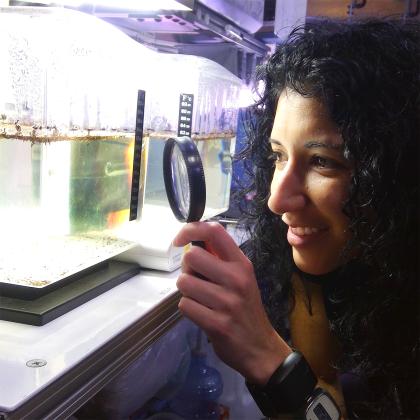Monique “Moxie” Garcia

A MITRE Engineer Takes on a NASA Mission That's Out of This World

Sometimes a fresh perspective requires a little space. That’s just what Monique “Moxie” Garcia, a Colorado Springs-based MITRE human factors engineer, discovered during a 45-day simulated journey to Mars. Alongside three other volunteer research subjects, Garcia decamped to NASA’s Johnson Space Center in Houston as part of the Human Exploration Research Analog (HERA) Campaign 6, Mission 1.
Working and living full-time in a ground-based habitat designed to mimic the isolation and confinement of the International Space Station (ISS), the crew took a simulated journey to Phobos, one of Mars’s moons. Data from this and future HERA missions will help inform exploration missions to the moon, Mars, and the planned lunar Gateway. Garcia returned to Earth with a grand adventure behind her—plus revelations about her work and life.
I wasn’t really space-obsessed growing up. I was a curious kid who enjoyed playing and exploring without knowing exactly what I wanted to do. Whenever I came across anything that sounded fun and exciting, I would try it out and see where it led me.
But when I was in grad school, I became fascinated about the physiological and psychological changes of human spaceflight. I came across HERA and noticed I was eligible to apply.
I’m sure having MITRE space-related projects on my resume helped get me a call back!
After more applications, a flight physical, and psychological evaluations, I was selected as one of four primary analog “astronauts” for our mission.
The mission meant I’d be away from the office for six weeks. Fortunately, MITRE is great at serving up opportunities to help employees grow. The company recognizes the value that a diverse background—for me, 12 years in the military and a master’s in kinesiology—and outside interests bring to our work.
Space Days Filled with Experiments

Our days in the habitat were extremely regimented and closely aligned to what astronauts experience on the ISS. We had a full schedule, starting with “leaving Earth,” then sling-shotting around the moon, arriving on Mars, doing our experiments there, and coming home.
Inside this capsule environment, we were truly treated like astronauts. We chose our wakeup music ahead of the mission, so every morning Mission Control would broadcast a song we’d selected. One of my favorites to wake up to was “Starman” by David Bowie. Then we’d turn on the lights and get our experiments ready for the day.
Our experiments included performing various tasks on the surface of Phobos, then returning to the spacecraft. In one of my favorite tasks, extravehicular activities (EVAs), we went through airlock decompression and repressed—which means performing all actions in reverse while my partner and I were in the simulated airlock—before exiting and walking back to the habitat’s main levels. Every day, we were graded on accuracy.
In the beginning, we were given specific instructions. NASA then phased in autonomy for us to prioritize what tasks we wanted to perform over time.
In addition to the daily routine and planned experiments, we participated in simulated emergencies or errors and followed the appropriate procedures. EVAs were really fun because we got to don our equipment and practice an EVA on the surface of Phobos.
One dramatic change to our schedule was a sleep-deprivation exercise to observe the cognitive decline caused by irregular circadian rhythms in space. That day, we had to eat a little less and sleep a lot less. Things went back to normal the next day.
Back to Earth, Back to MITRE

I don’t think anyone goes into this kind of experience expecting huge, life-changing thoughts in the process. But the isolation was surprisingly impactful for me—great for reflection.
I spent time thinking about how I want my future to look, professionally and personally. Separation from external stimulation helped us all to home in on ourselves and our work—what we want to do and how it will contribute to our world.
My goal was having opportunities that would allow me to expand on research I was genuinely curious and excited about. I wanted to interact with great technology and great people. I wanted to develop new thoughts on research that would benefit MITRE and our sponsors.
The next step? Making these tasks feasible for upcoming MITRE independent research projects.
—as told to Nancy G. Romps
Join our community of innovators, learners, knowledge-sharers, and risk takers. View our Job Openings.